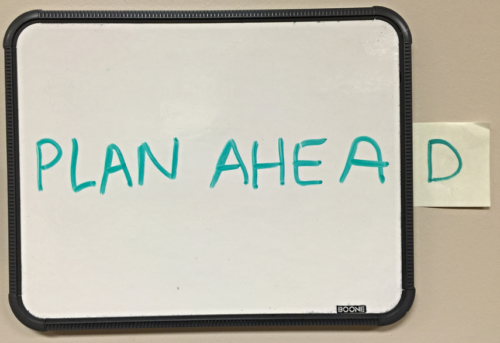You Need a Plan, But Are You Ready?
As a business leader of your organization or company, you have many big ideas. And for the biggest idea, your logical next step is to define a plan and your team will make it happen. But do you really need a plan? Spoiler Alert! Yes, you do…but maybe not yet. You’re ready for a plan …
If you have a developed idea and:
- You have a complex organization that needs to stay on the same page on a project.
- You want to ensure a seamless customer experience.
And have more pre-work if…
- Your idea isn’t mature enough or tested.
- There’s no consensus about what reaching a visionary idea would look like.
- You run into resistance as you socialized your idea and confirmed you don’t have buy in.
Would you hop in the car in a new city with a map (or GPS) and just hope to get to your destination? That’s what happens when you start a project without a plan. Now imagine you’re driving a van and everybody in has a different idea about how to get there. Chaos.
A plan is your map with your route set out from the start. Instead of wondering where to turn next or setting off in one direction only to realize you need to go someplace else, first, you figure out the best path from point A to point B. Then you follow the route you mapped out.
How a Plan Saves You Time
You know where you want to go. Your end result is clearly defined and cemented. It may be similar to something you’ve done before. In fact, you may be tempted to skip the plan because, you “know what you’re doing.”
Knowing generally how to get from point A to point B may work but having a specific plan of how to get your improved product to market will be more efficient. According to trainer Brian Tracy, 10 minutes of planning can save you almost two hours of time. That means an hour of planning can save you up to 10 hours in execution. Let that sink in.
With a plan, you have a clear timeline, everybody knows the exact steps that need to happen, and how each step affects the rest of the team and timeline. You even thought of the unexpected and have alternate options identified. Execution may not be perfect but starting with a plan gets you off to a strong start and keeps you from faltering along the way.
And plans aren’t only for product or service launches. Plans are a more effective way to:
- Overcome training gaps
- Absorb an acquired company into your processes
- Drive customer loyalty with improved services
- Consolidate customer offerings into one global offering
When You Absolutely Need a Plan
Let’s be clear: You need a plan about 99% of the time. I’ll talk about when to scrap a plan in a minute, but let’s look at two reasons a plan is essential.
Keep Everybody on the Same Page
The bigger or more complex your organization is, the more essential a plan is. Don’t get me wrong, even a solopreneur does better with a plan, but the more people involved, the more teams or cross-functional organizations pulled in, or the more sophisticated the deliverables are – the harder it is to function effectively without a well thought out plan.
If you have groups throughout your company or around the globe involved with a project, you need a plan to keep everybody on the same page. You want everyone pulling in the same direction to deliver one or several project outcomes. And you need communication. Part of a plan defines leadership and communication channels to keep things running smoothly. Imagine if each group were just doing their own thing and hoping the pieces came together in the end.
Keep Your Customers Happy
Plans affect customer experience. Whether your customer is a client, prospect or staff member – you want your customer to see a polished product and solid messaging. With a hearty, well executed plan, they will. They will also see the value in the offering and understand why they need it.
Without a plan, customers may experience slow roll out of expected products or services. They may get inconsistent information or messaging, which can cause distrust, uncertainty or weaken your brand. They may get the sense you don’t know what is going on—and if you don’t have a plan, they’re right. A well-executed plan provides a smooth customer experience.
When You’re Not Ready for a Plan
I said that you need a plan 99% of the time, but are you ready for a plan? There are a few cases where a plan isn’t going to be effective.
You Haven’t Done the Research
If you create a plan when an idea is in its infancy stage, you may not know enough to make the plan effective. In that case, you may need to explore the idea further, do more research or validate the idea with customers before creating an effective plan.
For example, I worked with a client where they wanted to establish a formal partnership with industry experts to offer expertise they felt their customers needed. After a semi-formal market validation, my client presented the partnership idea to their customers for feedback. They learned the industry expertise was needed—and most of their customers already found it elsewhere. Furthermore, my clients’ customers didn’t expect this service and expertise from them. What an invaluable discovery!
With these results, my client scrapped the plan to establish a partnership, saving tons of time, money, and effort.
Your Idea is Visionary but Lacks Focus
If an idea is so forward thinking that you don’t have enough to go on then you may not be ready for a plan. One of my clients wanted to “fix their pricing model.” They felt it had become overly complicated as the company grew and was misinterpreted and used inconsistently. They talked with other organizational leaders within the company and got buy-in.
Normally, the next step would be a plan. I talked with several leaders in greater detail and asked questions like: What’s really broken? What are customers expecting when looking for a price? What do competitors offer? What would you like to see changed or improved? The feedback to this line of questioning ran the gamut from “our pricing probably isn’t that bad and we can get by with a standard price rate sheet” to “clients and market research shows we’re overpriced and until this is addressed then we’ll never hit our revenue targets this year”.
This visionary idea had buy-in from key leaders and stakeholders, but no clear focus. Until there was greater clarity about the problem and direction of the solution, a plan was unlikely to work. When you have a visionary idea, you may need a brainstorming session to flesh out the details and get clear. You may also need someone to guide you through the vision, problem, and desired results to gain enough focus to create and execute a viable plan.
Your Idea Lacks Buy-In.
In the last example, there was buy-in but not a clear goal. I’ve also worked with a client who had a clear plan and very clear desired results but lacked buy-in from key stakeholders.
This organization felt strongly that developing their employer/employee brand and establishing competitive recruiting and stronger on-board staff training was necessary to remain competitive with companies competing for similar caliber recruits. But buy-in was incomplete. After speaking with organizations directly involved in the success of this idea, I found immensely different views about whether this was an area of the business that needed attention.
To establish their employer/employee brand (and move from idea into a plan), they needed stakeholder organizations to agree this goal was important. They also needed those stakeholder organizations to agree to commit time, effort and resources to the idea before considering a plan.
If there’s resistance across the team or stakeholder organizations, then the plan will go nowhere. If you recognize the lack of buy-in before you create a plan, you need to address buy-in first. If you find lack of buy-in once a plan is in motion, it’s time to examine what’s really behind the resistance. Is the idea bad? Is something in the plan unworkable? Often a plan doesn’t need to be scrapped entirely, but the direction may need to be tweaked or adjusted.
Bottom line? You need a plan. You may need to gather more information and refine ideas before you create one. You may need to get stakeholders on-board before you develop it or tweak the plan to get people on board. But a good plan takes these pieces into account. It starts with assessing the idea, gathering information and then mapping it out—and it includes places for feedback and check-ins throughout the planned journey to make sure the direction continues to make sense.
Get a Handle on Your Plan
Whether you need to do the work to get ready for a plan or you’re ready to create your plan and move your idea from plan to action, we can help. Or, perhaps, your unsure what your next step is — or how to make it happen? Let’s talk about where you are with your plan and what you need to move forward.
Download or View this Article as a PDF







